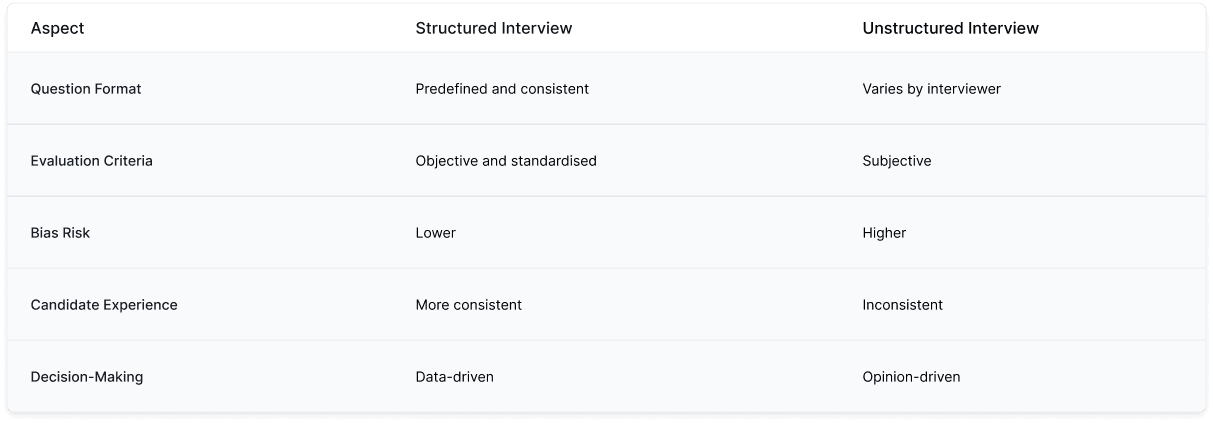


How to Create a Structured Interview Process that Improves Hiring Decisions
Hiring the right talent is one of the most critical decisions any organisation makes. A bad hire can cost far more than just salary - it can affect productivity, team morale, and even customer satisfaction. Yet, many hiring processes rely on unstructured interviews, where each interviewer asks different questions, evaluates candidates differently, and makes decisions based on subjective impressions. A structured interview process changes that. It creates a consistent framework for evaluating candidates, ensuring that decisions are based on role-specific skills, relevant experience, and cultural fit rather than gut feeling.
In this guide, we will walk through:
What a structured interview process is
Step-by-step instructions to build your own
Common mistakes to avoid
How tools and templates can make the process more efficient
Why it leads to better hiring decisions
Whether you’re part of a small HR team, a recruitment agency, or managing high-volume hiring across multiple regions, this is your playbook for more effective interviews.

What is a Structured Interview Process?
A structured interview process is a method where every candidate for a given role is asked the same set of predefined questions, evaluated against the same criteria, and scored using a consistent system It typically includes:
- Predefined questions aligned with the job requirements
- Clear evaluation criteria with scoring guidelines
- Standardised format for all interviewers
- Documentation to compare candidates fairly
Structured vs. Unstructured Interviews

Why Structured Interviews Lead to Better Hires
Research consistently shows that structured interviews are more predictive of job performance than unstructured ones. Benefits include:
- Consistency Across Candidates Every applicant is assessed in the same way, making it easier to compare applicants fairly.
- Reduced Bias Standardised evaluation reduces the influence of personal preferences or stereotypes 🔗 Read next: Reducing Bias in Recruitment with AI
- Improved Candidate Experience Candidates perceive the process as more fair and transparent.
- Data-Driven Decision Making With standard scoring, hiring managers can make decisions based on actual performance in interviews, not vague impressions
Step-by-Step Guide to Creating a Structured Interview Process
1 . Define the Role Requirements
Start with a clear job description that outlines the responsibilities, must-have skills, nice-to-have skills, and cultural attributes. If you need a faster start, you can use pre-made job description templates that are optimised for both search visibility and inclusivity.
2 . Choose the Interview Format
Decide whether the interviews will be:
- Panel Interviews - Multiple interviewers assess the candidate together.
- One-on-One Interviews - One interviewer per sessionBias in Recruitment with AI
- Virtual Interviews - Ideal for remote or global hiring
For fairness, keep the format consistent for all candidates for a specific role.
3 . Create Standardised Questions
Questions should be aligned with the job requirements and competency areas.
- Behavioural Questions - “Tell me about a time you had to solve a challenging problem.”
- Situational Questions - “What would you do if a client gave conflicting requirements?”
- Technical Questions - “Walk me through your process for debugging a software issue.” Explore: Top Interview Questions for Different Roles
4 . Define Evaluation Criteria
Identify the skills and qualities you want to assess, then assign weightings.
- Relevant Experience -25%
- Technical Skills - 20%
- Communication Skills - 15%
- Cultural Fit - 15%
- Problem-Solving - 15%
- Overall Presentation - 10%
For fairness, keep the format consistent for all candidates for a specific role.
5 . Use a Candidate Evaluation Scorecard
A scorecard ensures consistent scoring and easy comparison between candidates. You can download a free Candidate Evaluation Scorecard to start assessing applicants with clear, weighted criteria.
6 . Train Your Interviewers
Even the best-designed process can fail if interviewers don’t apply it correctly. Training should cover:
- How to ask questions without leading the candidate
- How to score objectively
- How to document notes clearly
For fairness, keep the format consistent for all candidates for a specific role.
7. Document and Review Results
Store scorecards, compare results, and discuss discrepancies before making a decision. In a digital setup, this also enables cross-team visibility - especially useful for recruitment agencies or organisations hiring across multiple locations
Common Mistakes to Avoid
- Not Testing the Process - Run a trial with internal candidates before applying it live
- Asking Irrelevant Questions - Keep questions tied to the job requirements
- Ignoring Interviewer Feedback - Scorecards help, but debrief sessions are equally important
- Failing to Review and Improve - Regularly refine your process based on hiring outcomes.
Bringing It All Together
When combined with tools that allow you to store job descriptions, manage candidate scorecards, and collaborate across teams in real time, a structured interview process becomes even more powerful.
For example, if you manage hiring for multiple departments or clients, a multi-workspace setup ensures that interview criteria, candidate notes, and progress tracking remain organised and isolated per project - making it easier to maintain process integrity while handling high volumes.
If your organisation wants to ensure fairness, reduce bias, and improve decision-making, starting with a well-planned structured interview process is one of the most effective changes you can make.
Conclusion
structured interview process is more than just a hiring checklist - it’s a proven framework for making confident, fair, and consistent hiring decisions.
By defining role requirements, standardising questions, scoring objectively, and using collaborative tools, you can significantly improve the quality of your hires.
Next Step: Download the free Candidate Evaluation Scorecard and start structuring your interviews today.

